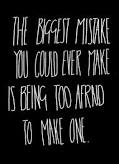One of the biggest obstacles in life generally speaking is FEAR (False Evidence Appearing Real). It is also one of the biggest obstacles in business. I recently came across this article and I’d like to share a few points from it.
“I’d like to start a small business but…”
Does this describe you at this point?
What’s holding you back?
When I get the chance to ask people this question in person, often they respond that they’re afraid of failing – not in so many words, mind you, but that’s what it boils down to.
They say things such as “I’d like to start a small business but I don’t know if enough people would be interested in buying this product.” Or “I’d like to start a small business but I’m not very good at selling.” Or even “I’d like to start a small business but I don’t know if I could make enough money to live on.”
See? The obstacle to starting a small business is not actually about products or selling or money – it’s fear.
Now fear that saves you from physical harm, such as the fear you feel when you see a huge slavering dog standing in your path or the fear that prevents most of us from shooting over Niagara Falls in a barrel, is a healthy thing. But the kind of fear that prevents you from doing things that you want to do that will enrich you is not.
If fear of failure is what is preventing you from starting a small business, you have to get around it and forge ahead.
How can you break your paralysis and do this? You have to do two things:
- Prepare to succeed
- Change your attitude to failure
1) Prepare to Succeed
The first thing you need to do to prepare to succeed is to learn how to do it. You already know how to fail. You can fail by doing nothing or you can fail by doing stupid things. But how do you succeed? By finding out exactly what you would need to be successful and ensuring that those needs are met.
For instance, suppose that I want to start a small business selling herbal soaps and bath products. For this business to be successful, I need to have essentially three things:
- Enough people who want to buy the soaps and bath products I’m selling
- A product whose quality and price is competitive enough that people want to buy it
- A way to bring the two of these (people and product) together
So there are the basic needs. Now all I have to do is figure out how to meet these needs. The best way to do this is to work through a business plan. The Business Plan Outline will lead you through the process of writing a business plan of your own. Working through a business plan will fill in the gaps in your knowledge and provide the details of how you’re going to do what needs to be done to start and run a particular small business successfully. Your business plan will be, in effect, your blueprint for success.
2) Change Your Attitude towards Failure
Why are you afraid of failure?
Most people fear failure for one of these two reasons:
- Failure makes you a bad person, a “loser” that others look down on.
- You could lose all or most of your money and/or your possessions.
Both of these are misconceptions. Failure doesn’t change your genes or your personality. It affects some people’s actions negatively, but it’s not negative in itself. Will you be a “loser” if you fail? Well only if you allow yourself to be. “It’s not being down; it’s staying down” that makes you a loser.
Will others look down on you? Some people might. You can’t control the thoughts or actions of other people – so why lose sleep over them?
My point is that failure can be uncomfortable and unpleasant, but is not life-threatening. And failure is always an opportunity of one kind or another – an opportunity to stretch beyond our usual boundaries, to learn something valuable, or to make previously undreamed-of connections. Remembering this positive face of failure and focusing on it will go a long way towards changing your attitude about it.
Starting and running your own small business could be one of the most enriching experiences of your life. Don’t let your fear of failure make you miss out.
You are not going to be able to outrun your fear. But eventually, once you build on enough successes, you will be able to tame it. Why not start now?








